Are you looking for some amazing facts about the marabou stork? You’re in the right place!
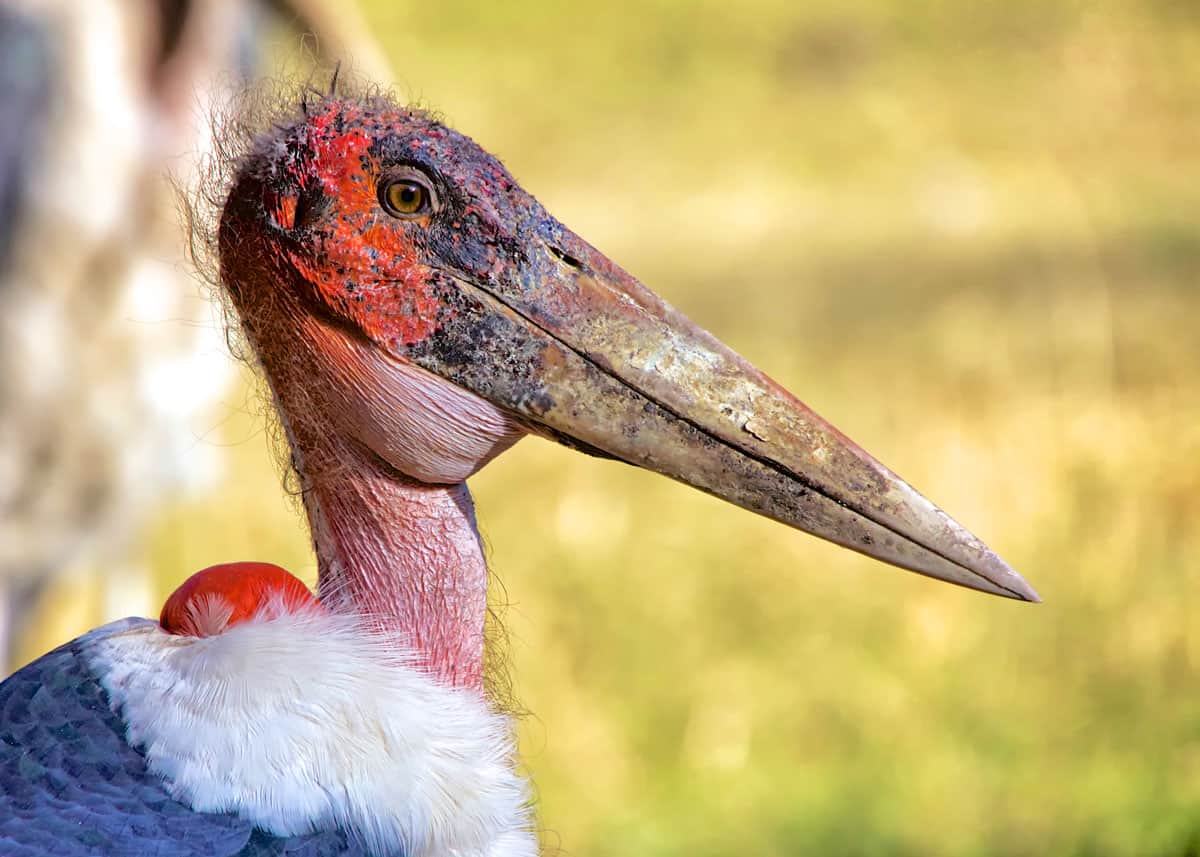
Table of Contents
39 Marabou Stork Facts
Also known as the “nightmare bird” or “undertaker bird,” the marabou stork is one of the ugliest creatures in Africa. It has some pretty gross habits, too, like scavenging for garbage and wearing its own feces.
But did you know that marabou storks also play an important role in cleaning up the African savanna? Were you aware that their feathers have been worn by people like Marilyn Monroe?
There’s a lot more to marabou storks than their appearance might suggest. Let’s take a look at some marabou stork facts and find out more!
1. What does the marabou stork look like?
The first thing that you’ll notice about marabou storks is that they’re hideous. They have beady eyes in scabby pink faces with huge gullet sacs dangling from their necks.
Marabou storks also have large black wings and skinny white legs. This is part of the reason why they’re nicknamed after undertakers: they look a lot like people who work in funeral homes.
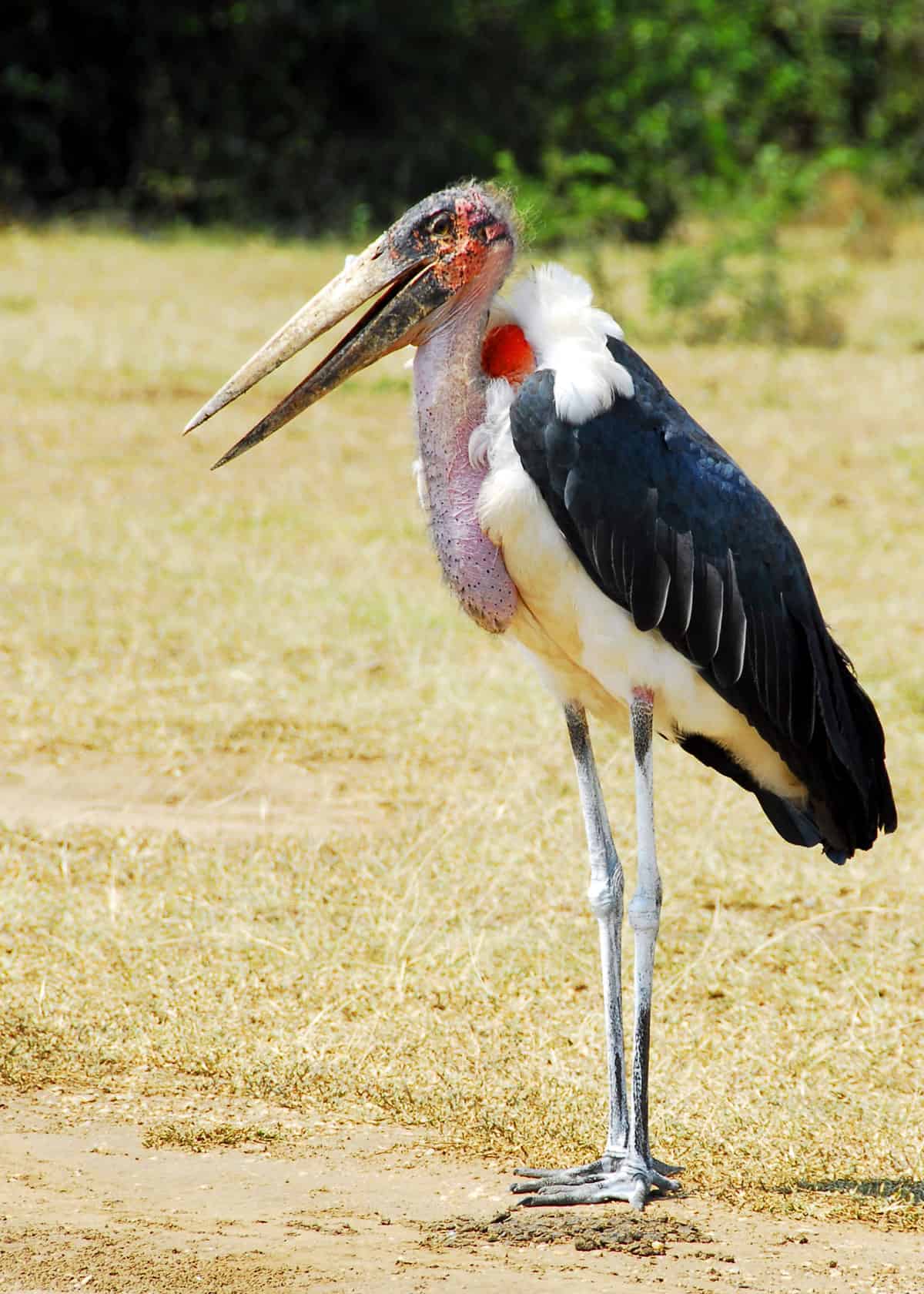
Something else to note about marabou storks is that they’re completely bald. This is to keep them clean as they pick through animal carcasses.
If they had fur or hair, it would quickly become weighed down with blood, guts, and viscera, and that’s just asking for an infection.
Marabou storks are some super weird birds!
2. Why do marabou storks have an inflatable pouch?
The inflatable pouches are called gular sacs, and they’re normally used for food storage. For example, seabirds scoop and carry fish in them until they’re ready to eat.
With marabou storks, however, their gular sacs are mostly used for mating. The males will puff them up when trying to attract a female. Since their gular sacs can reach 18 inches long even before they’re enlarged, this makes them quite the sight!
3. How tall is a marabou stork?
Marabou storks are startlingly large. They reach 4 – 5 feet tall, so they tower over other birds. And they’re just a little shorter than the average adult woman in the U.S!
4. How much does a marabou stork weigh?
Marabou storks weigh anywhere from 10 – 20 pounds. Most of their weight is carried in their heads and torsos; their legs are like sticks in proportion to the rest of their bodies.
5. What is the marabou storks wingspan?
The marabou stork has one of the largest wingspans of any land bird. When fully extended, their wings measure about 12 feet long from tip to tip. This size is matched only by pelicans and condors.
6. How does the marabou stork keep cool?
Marabou storks have a unique way of keeping cool in the hot African desert: they poop on their own legs.
It might sound nasty, but it’s a legitimate scientific process called urohidrosis, and it’s practiced by storks, vultures, and other birds.
The liquid content of the feces triggers evaporative cooling and helps to regulate internal body temperature. In other words, it keeps them cool.
7. Are marabou storks friendly?
While not truly friendly, marabou storks have grown used to humans.
They’ll scavenge for food anywhere, and this includes dumps and landfills made by human populations.
They’re familiar with the sight of weird featherless birds scurrying around with clipboards.
8. Are marabou storks aggressive?
Marabou storks can get quite aggressive. They’re known for having short fuses, and they’ll snap and strike at anything that triggers their tempers.
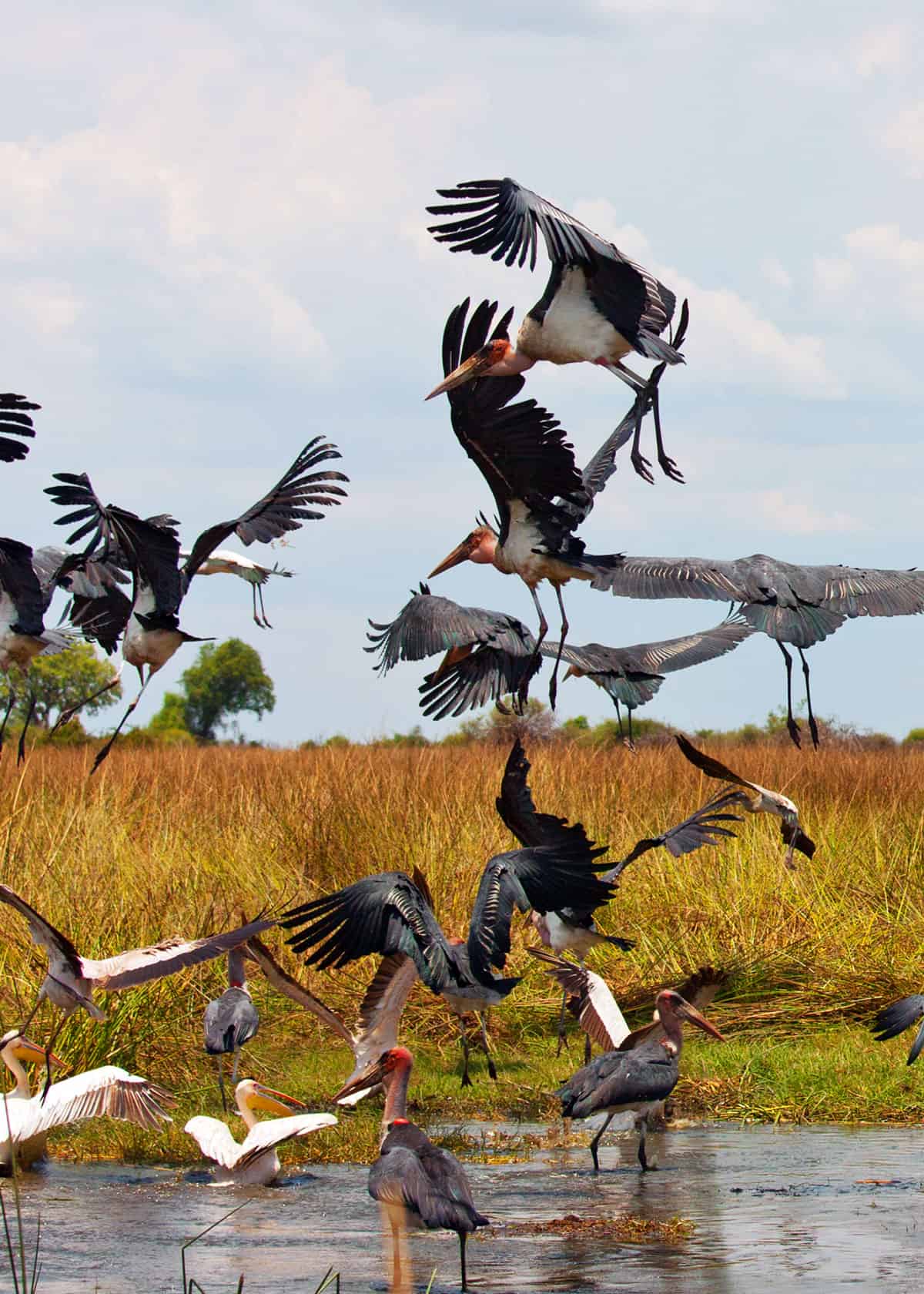
Since their beaks protrude about 50 inches, this results in a mean pinch! They’ve even been known to lash out at humans when humans interrupt their dumpster diving.
9. Do marabou storks fly?
Yes. Despite their large size, marabou storks are capable flyers. They utilize several tricks to keep them in the air.
They’ll tuck in their chins to decrease wind resistance, and they’ll let their legs trail behind their wings to keep the extra weight from dragging them down.
10. How high can a marabou stork fly?
Marabou storks can reach heights up to 13,000 feet, but they don’t always fly that high. They mostly take to the air for scavenging purposes, so they stay close to the ground to look for food.
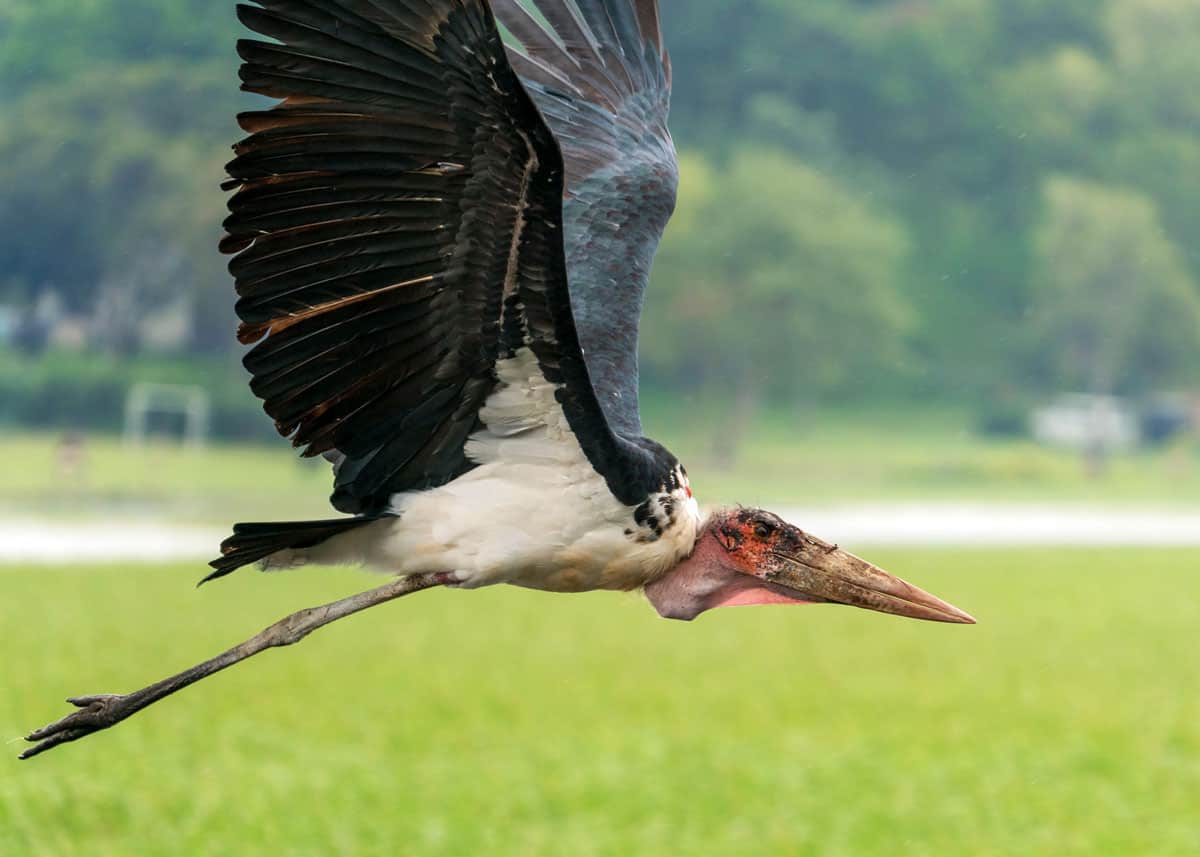
11. Why do marabou storks fly towards fire?
When there’s a bushfire, there are scared and panicked animals fleeing from it.
Marabou storks are intelligent enough to understand this, so whenever they spot the tell-tale flames, they swoop towards them and look for dinner. They can catch all sorts of bugs, reptiles, and small mammals during a fire.
12. How long do marabou storks live?
According to the Max Planck Institute for Demographic Research, marabou storks can live 25 years in the wild and 41 years in captivity. The maximum age is believed to be 44.7 years.
13. Do marabou storks stand around all day?
It’s true that marabou storks like to conserve energy. They aren’t a curious or playful species, so in their downtime, they might spend long hours just standing and staring into space.
However, this shouldn’t be taken as a sign of laziness. Marabou storks often multitask while they stand.
For example, they spread their wings and sun themselves when they’ve gotten too cool, and they rest on their rear tarsi bones to encourage digestion after a long meal.
14. What eats a marabou stork? Predators and Threats
They’re so large and mobile that they aren’t easy prey, but marabou storks can be killed by anything with enough strength to take them down and keep them down.
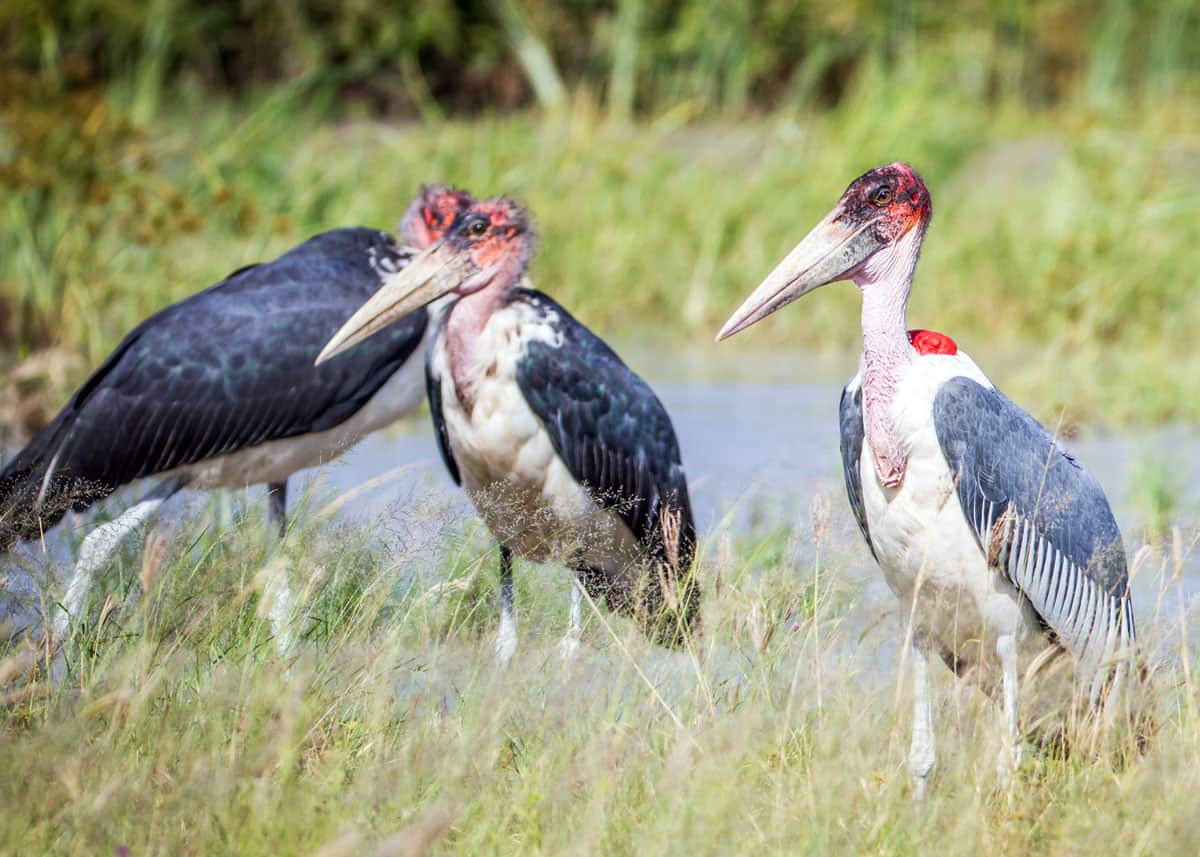
This is usually reserved for big cats like lions and leopards, but a determined jackal can also get the job done.
15. Is the marabou stork endangered?
Marabou storks aren’t in any danger. The International Union for the Conservation of Nature (IUCN) has them ranked as “least concern” on the extinction scale, and their population is increasing by the day.
This is pretty remarkable when you consider how many African animals have declining numbers thanks to things like habitat loss and hunting.
Fortunately for marabou storks, they can survive anywhere, and no one is killing them for their good looks.
16. What is the relationship between a bee and a marabou stork?
Marabou storks tear open animal carcasses to feast. If there’s anything left over, the bees can swarm in and use it for shelter or egg-laying purposes.
This is an example of a commensalistic relationship where two species exist in harmony because of one animal benefits while the other animal isn’t harmed by providing these benefits.
17. What is the relationship between a vulture and a marabou stork?
Marabou storks like to follow vultures to new scavenging sites. They know that the vultures will lead them to good carrion.

Sometimes, they’ll patiently wait for the vultures to finish eating before swooping in and taking the scraps; other times, they’ll fight or steal from the vultures directly.
18. Do marabou storks eat meat? What do marabou storks eat?
Marabou storks will eat anything. This isn’t even an exaggeration. They’ll kill, steal or scavenge anything that they can swallow, and this includes all kinds of fish, insects, reptiles, mammals, and amphibians.
They’ll eat both live and dead prey. They’ll steal eggs from the nests of other animals. They’ll pick through the carcasses that big predators have left behind.
They’ll even eat literal garbage. When marabou storks hang around landfills, they gobble up everything from shoes to metal industrial parts.
19. Do marabou storks eat flamingos?
Yes. These bottomless pits have no problem eating other birds. Flamingos are easy for them to catch – especially when the flamingos are young – so they frequently prey on them. They also enjoy doves, pigeons, pelicans, and queleas.
20. How much can a marabou stork eat at once?
If you thought that you could demolish a steak, think again. The marabou stork can consume almost two pounds of meat with a single swallow.
They can store even more in their stomachs since their stomach linings are elastic.
21. What is the marabou storks Latin name?
The scientific name for marabou storks is leptoptilos crumenifer. This comes from the Latin words for “thin” (lepto) and “feather” (ptilos).
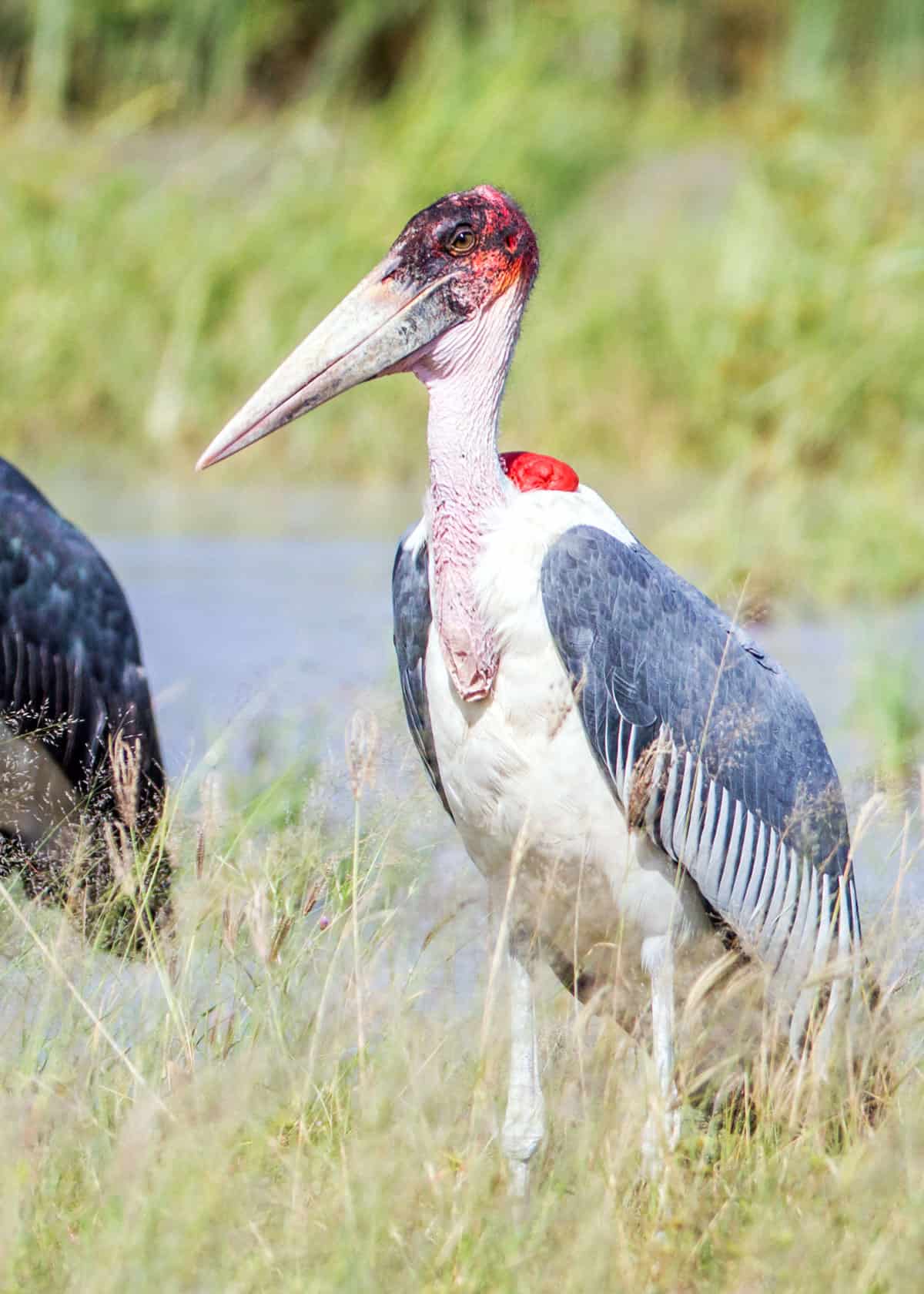
22. Do marabou storks mate for life?
Yes. Once they’ve found a mate, marabou storks remain monogamous until death does them part.
23. At what age do marabou stork lay eggs?
Marabou storks reach maturity at the age of four. It’s much later than a lot of birds, but hatchlings are dependent on their mothers for several years, and it takes even longer for them to gain enough independence to leave their stork group.
24. How often do marabou storks lay eggs?
Marabou storks can lay eggs once or twice per year. Their mating season usually corresponds to the dry season of their particular country.
It’s easiest for them to catch frogs and fish for their hatchlings when water levels are low.
Mating rituals include rattling and swelling their gular sacs to attract a partner. It’s usually males that court females, but females can also engage in ritualized behaviors to signify their readiness to mate.
25. How many eggs does the marabou stork lay? What do they look like?
Marabou storks lay 3 – 4 eggs at a time. They’re white with shades of yellow and gray, and they need to be carefully guarded to prevent predators from stealing and eating them. They take about a month to hatch.
26. What are marabou stork babies like?
Hatchlings are tiny, pink and wrinkled. They weigh around 2.5 ounces and are usually covered in a whitish down right after birth, but they might need extra time to grow it. Their feathers will start to come in a few weeks later.
Young marabou storks are extremely dependent on their mothers. They can’t walk, fly, forage or flap their wings by themselves, so they stay in the nest and beg for food with open beaks. Their mother will regurgitate fish and insects until they’re ready to consume things whole.
As previously mentioned, they won’t leave their mothers until they’re around four years old. Only one out of three hatchlings will survive to this age.
27. What do you call a group of marabou storks?
A group of storks is called a “muster” or “phalanx.” These terms aren’t widely known outside of birding circles, however, so most people just use “group.”
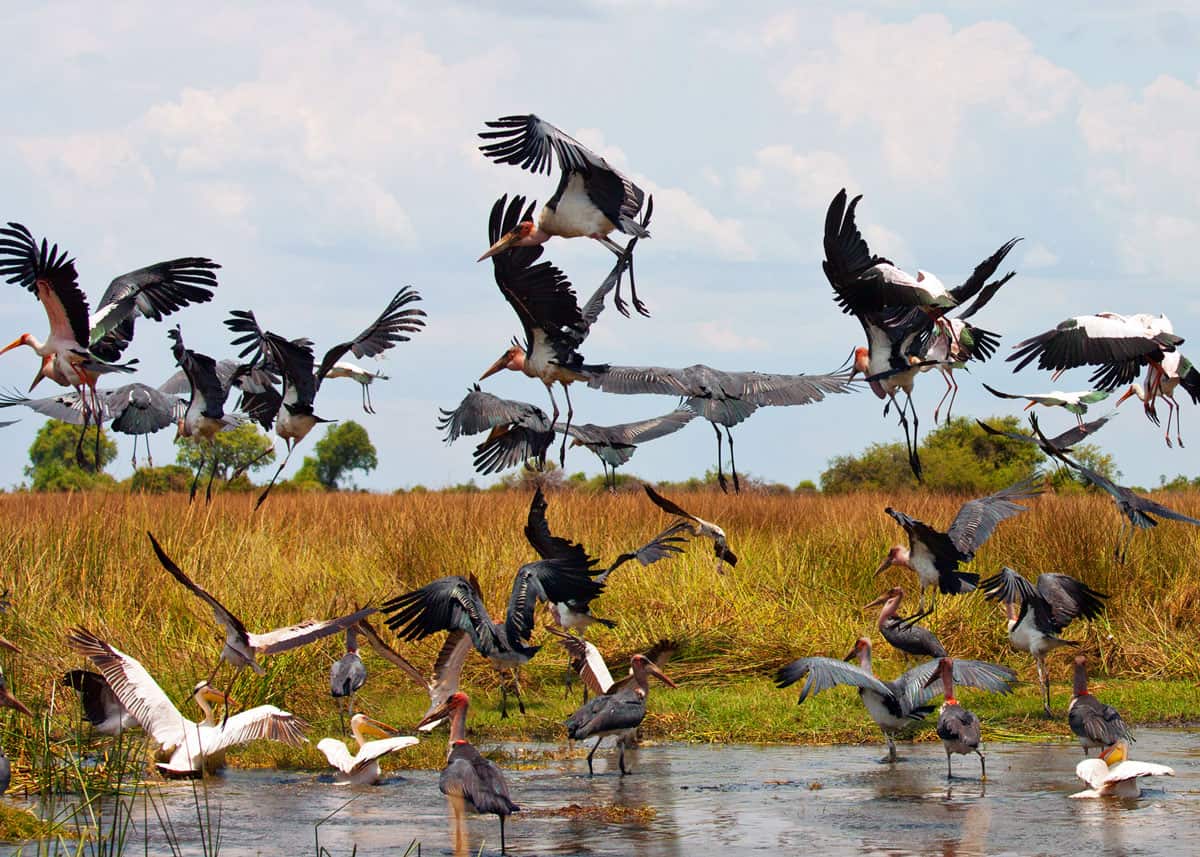
28. How many marabou storks live in a group?
It’s hard to pin down the marabou stork. Some of them live solitary lives, and others join large groups of their kind. The average group is around 20 members, but some have been known to swell to 100 members.
As a rule, marabou storks don’t migrate south for the winter, but they might take migratory journeys to find better hunting or nesting grounds.
When this happens, they can create groups of 1,000 or more. All of the marabou storks in a region will collectively move on to greener pastures.
29. What is the marabou storks call?
The marabou stork doesn’t have a true call, but it can make a variety of noises to express dominance or attract a mate.
The most common noise is something known as “bill-rattling” where the stork bangs its gular sac against its body, but there are also croaks, groans, whistles, whines and guttural sounds that it might use in social settings.
30. Are marabou storks loud?
Marabou storks aren’t loud at all. In fact, the word “marabou” is thought to derive from the ancient Arabic term murabit, and this translates to “silent, quiet and hermit-like.”
Marabou storks don’t even have voice boxes: They make their sounds through vibrations in their noses and gular sacs.
31. Do marabou storks have hollow bones?
Yes. The legs and toes of marabou storks are completely hollow. This is what enables them to fly; if they were weighed down by large, lengthy bones in their legs, they couldn’t take to the sky without difficulty.
32. Do marabou storks carry disease?
Marabou storks carry a lot of parasites, including tapeworms, flatworms, and nematodes.
While they don’t pose a significant risk to human health, you still wouldn’t want to cuddle with one.
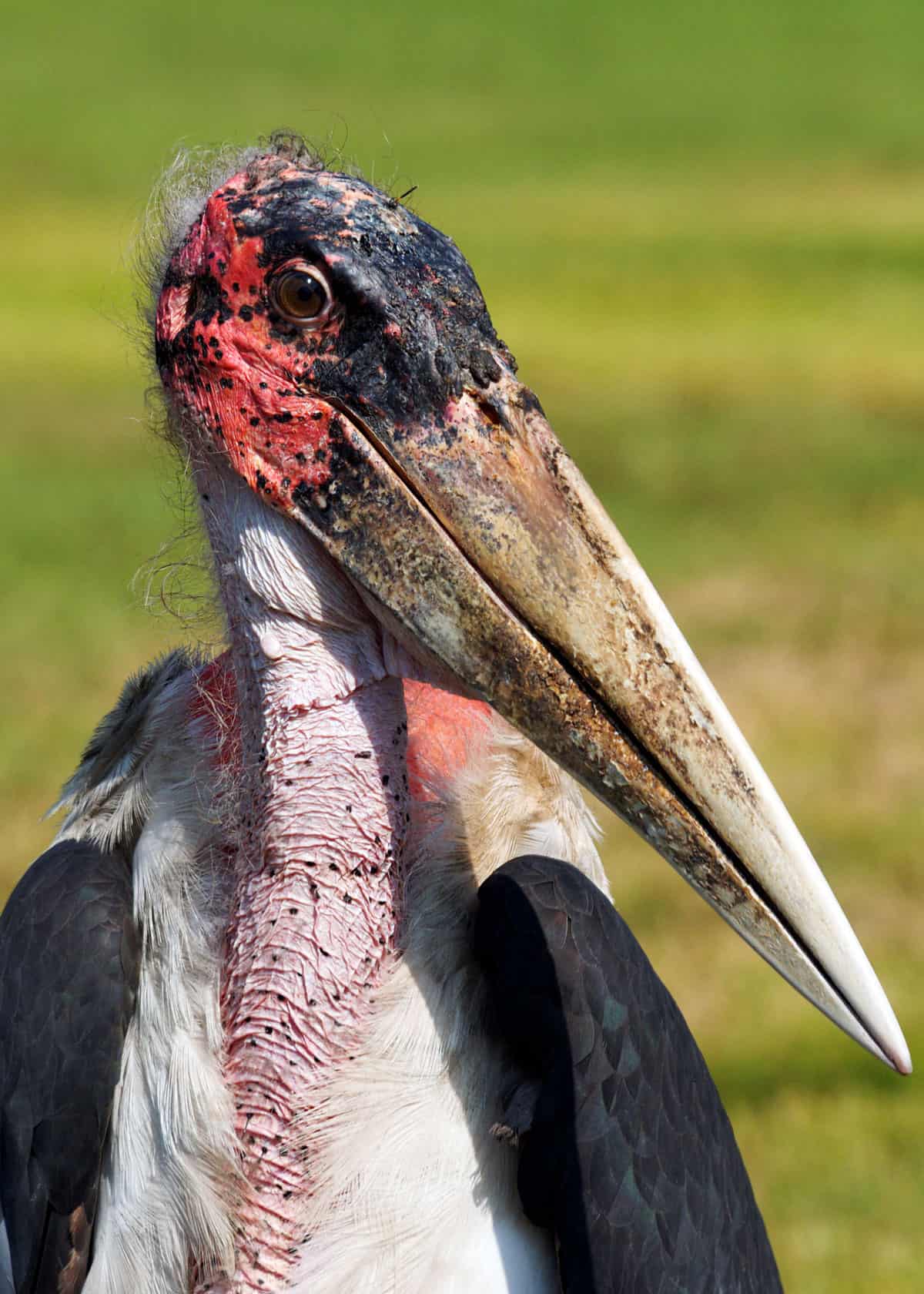
Their garbage-eating might get them through the day, but it also leaves them with a lot of creepy-crawlies on their feathers and in their bellies.
33. Is marabou stork meat poisonous?
It isn’t poisonous, but it’s a definite health hazard.
Since marabou storks will dine on trash, scraps, carcasses, and even feces, their meat can be dangerous to consume. You never know what kinds of germs have been transmitted to it.
34. Can you eat marabou stork meat?
It won’t kill you to eat marabou stork meat. In fact, there are street markets in Africa that will chop, roast, fry and skewer it as a cheap snack for locals.
However, this practice is condemned by everyone from bird experts to public health officials. They warn that the meat could be contaminated thanks to the indiscriminate scavenging of the storks.
In 2017, there was even a hotel in Nairobi that came under fire when it was discovered that the chefs were using marabou stork meat instead of chicken. They made headlines for potentially exposing their customers to diseased dishes.
35. Where does the marabou stork live?
The marabou stork is native to Africa. It can be found in sub-Saharan countries like Uganda, Senegal, Botswana, Ethiopia, Somalia, Sudan, and Namibia. Strangely, its range seems to stop at the tip of South Africa; it doesn’t venture any more south than that.
36. What is the habitat of the marabou stork?
Marabou storks like dry environments. They’re commonly found in savannas, grasslands and other arid or semi-arid places without a lot of rain. Their ideal hangout is:
- Dry
- Open
- With a nearby water source
- Basically, an area where they can have their pick of unsuspecting animals that come scurrying for a drink
When humans are added to the mix, however, marabou storks will abandon the wilderness and go for the garbage (*yum).
They’ll congregate around villages, dumps, landfills, and slaughterhouses where humans discard their waste. Over time, they can become so accustomed to this method of feeding that future generations are dependent on trash to survive.
37. Where do marabou storks nest?
To protect their eggs, marabou storks like to nest in high cliffs and trees. This might translate to rooftops in residential areas.

Both males and females participate in the nest-building, and they’ll use twigs, branches, and leaf stem to construct it. When they’re done, they’ll take turns guarding the eggs until they hatch.
38. Where can I see the marabou stork?
Do you need to see these scabby scavengers in person before you can believe that they exist? The easiest way to find a marabou stork is to visit a zoo.
They’ve been exported all over the world, so whether you’re in Tokyo or Toronto, you probably live near some.
If you want to see marabou storks in the wild, you’ll need to travel to Africa. You might schedule a safari through the open grasslands, or you might visit somewhere like Kruger National Park where they roam within its boundaries. Game reserves and wildlife sanctuaries are other options.
39. Are there any uses for the feathers of a marabou stork?
Believe it or not, but the downy feathers of marabou storks have been used in hats, muffs, shawls, shoes and feather boas since the 18th century.
It’s ironic that such an ugly bird has played such an important role in fashion, but it’s true! Marilyn Monroe even wore marabou-trimmed heels in the 1955 classic The Seven Year Itch.
Another use for marabou stork feathers is in fly fishing. They can be tied to lures along with bait.
Who’s the Fairest of Them All?
It’s undeniable that marabou storks could shatter a mirror if they cared to look in one.
Hopefully, however, you’ve come to understand that there’s a lot more to these creatures than being the guardians of garbage dumps. If anyone tries to tell you that they’re just ugly birds, use these marabou stork facts to change their mind!

Have you seen these birds in person? Which fact was your favorite? Is there anything we missed? Let us know in the comments, we love to hear from you!!
Drew Haines is an animal enthusiast and travel writer. She loves to share her passion through her writing.
She graduated high school at sixteen and started her own business, Everywhere Wild Media. And she runs Everywhere Wild and JustBirding. She also guest blogs on Storyteller.Travel
She lived in Ecuador for 6 years and explored the Galapagos Islands. Currently based in N.S., Canada.

Damian Higgins
Monday 6th of March 2023
There was a "muster" (thank you, Drew) of Marabou on the island of Lamu, Kenya... they perched on the tip of an outhouse overlooking the rubbish dump and some were busy scavenging. They looked menacing and mean and their wingspan was huge. You couldn't take your eyes off them but at the same time it was an unnerving experience. I'm glad to have seen them once but that was quite enough, thank you.
Adam
Monday 16th of August 2021
They hang out around the immigration office here in Nairobi . . . I always see them perched in trees and I'm like "YOU'RE TOO BIG TO DO THAT!!!"
Terrifying. Super intriguing.
Owen Dixon-Paver
Wednesday 24th of March 2021
Hi
A remark on their range... They are frequently seen in the Kruger National Park in South Africa and at least as far south as the Crocodile River. Where we live in Phalaborwa there is a large population at the landfill site.
Rod Richards
Friday 22nd of January 2021
I am reading a book entitled "Marabou Stork Nightmares." I had to do some more research on them! Thanks. Super informative.
derick
Monday 11th of January 2021
In Uganda, at the university of Makerere, we call these birds "Campussers" coz they are all over the university campus, on trees. You will not be surprised when they poop whitish staff on your head while you are walking through the university.